Fire is an important component of Florida landscapes. It maintains healthy and safe natural ecosystems (Figure 1; Diaz 2012) but can also be a safety concern near residential areas. Florida's frequent lightning strikes and human carelessness guarantee that accidental wildfire will continue to affect rural and suburban areas that are near natural areas (Long and Prestemon 2013). Some homeowners may wonder if they are in danger of wildfire. The purpose of this publication is to help homeowners, land developers, and interested individuals determine whether their properties are at risk and provide guidelines to reduce the threat of wildfire.
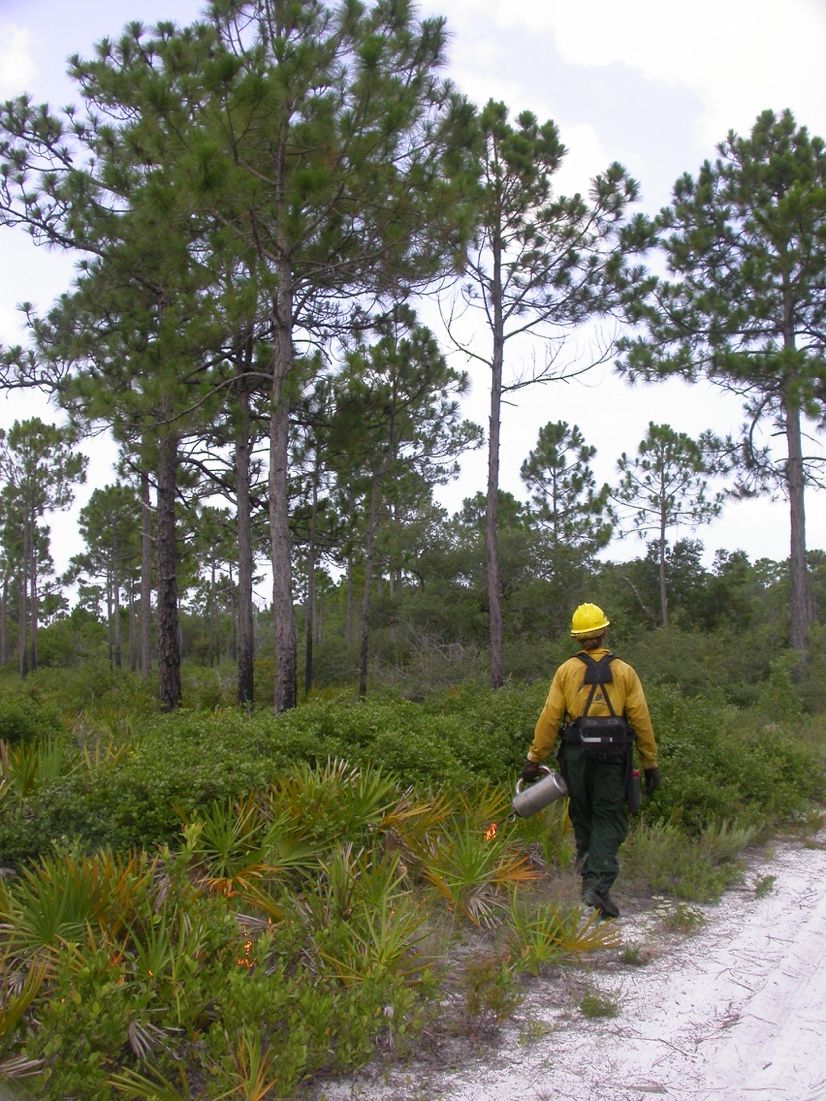
Credit: Raelene M. Crandall, UF/IFAS
Determine Your Risk
Wildfire risk depends on the landscape surrounding your community and the plants immediately surrounding your property. Fire can spread to your home by burning directly through vegetation up to your house or when embers carried from a nearby wildfire ignite vegetation (Campbell 2020). If you live in a home surrounded by natural woods or grasslands or with a yard full of flammable or dense plants such as saw palmetto and gallberry, you could be at risk if a wildfire occurs.
Walk around outside your home and look carefully at the defensible space. Defensible space is considered the area within 100–300 feet of a structure, depending on the slope of the land (Kays et al. 2020; Figure 2). The density, type, and amount of vegetation within this space affect your risk (Kays et al. 2020; Table 1). It is helpful to look at the horizontal and vertical arrangement of fuels (Campbell 2020). Low-risk landscapes have widely spaced plants, low-growing vegetation, and a generally clear view because there is vertical space between the surface fuels (grass or leaf litter) and elevated fuels (tree branches and leaves; Figure 3). Medium-risk landscapes have plants that are closer together and more flammable fuels such as pine needles and shrubs such as saw palmetto (Figure 4). High-risk landscapes have large, dense plants growing close together that connect the surface and canopy fuels (Figure 5).

Credit: North Carolina Forest Service
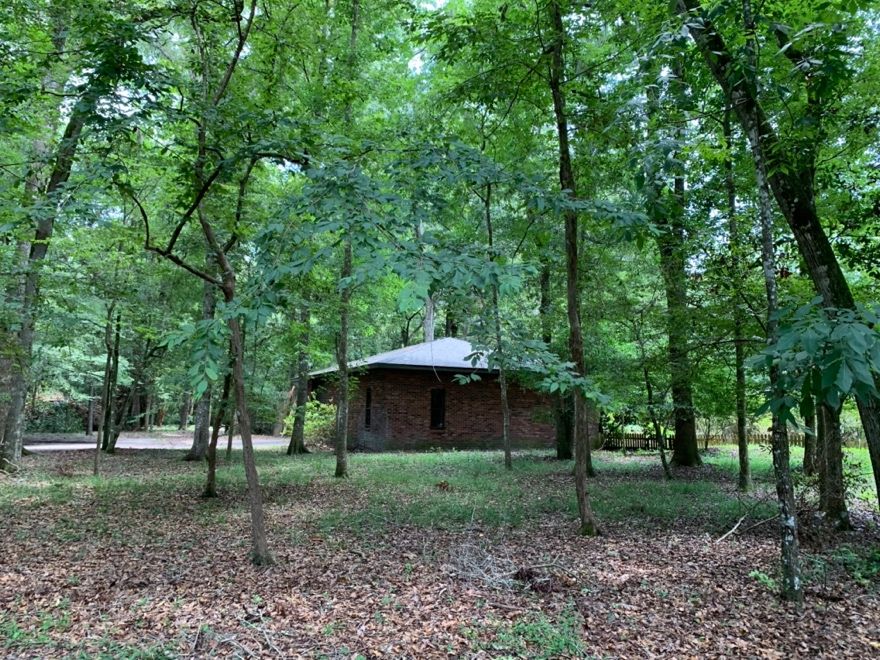
Credit: Raelene M. Crandall, UF/IFAS
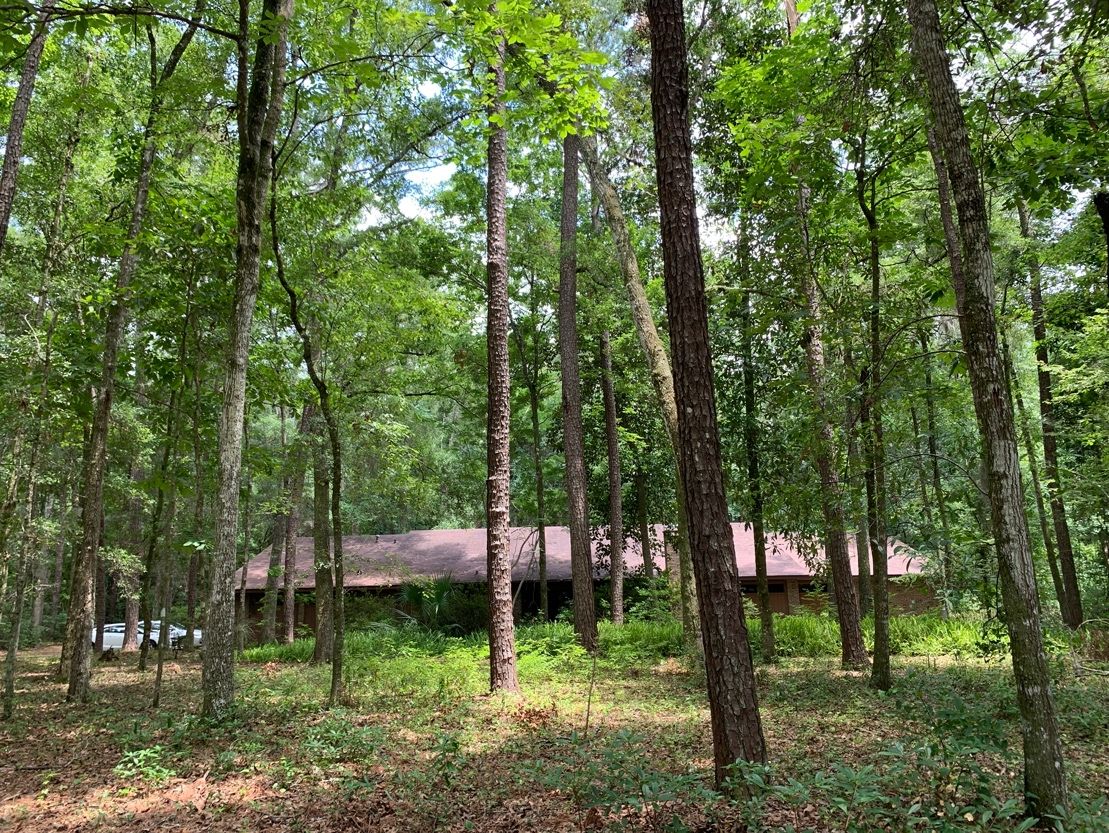
Credit: Raelene M. Crandall, UF/IFAS
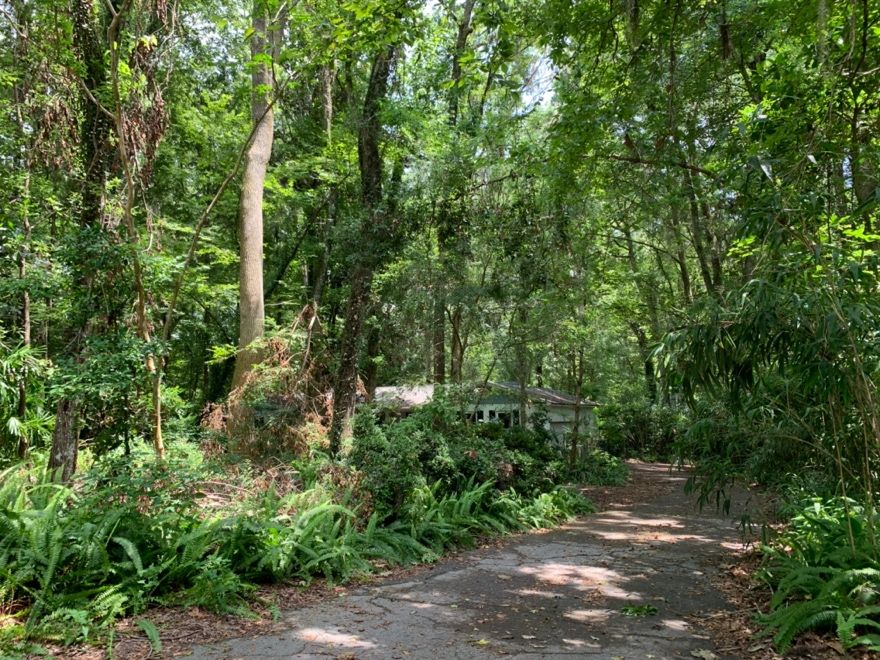
Credit: Raelene M. Crandall, UF/IFAS
Table 1. Summary of the effects of vegetation density, type, and amount on the level of wildfire risk.
Reducing Wildfire Risk
Just as coastal residents prepare for hurricane season, you should prepare for Florida's spring wildfire season. To protect your home, carefully consider the types of vegetation around your house and how you arrange them. This publication presents information on how to landscape the vegetation for a low-risk area of defensible space around your home. For tips and tools to make your house firewise by using fire-resistant materials and proactive measures, see “Developing Land in Florida with Fire in Mind: Recommendations for Designers, Developers, and Decision-Makers” (Monroe et al. 2022).

Credit: Raelene M. Crandall, UF/IFAS
You can create and maintain defensible space by choosing types of plants that are less likely to burn, such as beautyberry and coontie, and arranging them such that fire is less likely to ignite and spread through them (Behm et al. 2004; Doran et al. 2022).For example, plants such as palmetto shrubs burn intensely, and clumps of palmettos can easily spread fire to other plants directly or via embers. Refrain from planting flammable shrubs or ladder fuels such as vines (that connect the ground to the treetops) close to your home (Fill and Crandall 2019), keeping tree branches at least ten feet away from your house and any other structures (Kays et al. 2020). Unfortunately, invasive plants such as cogongrass are often planted as ornamentals. In fact, they should never be planted because they can support rapidly spreading, high-intensity fires (Fill and Crandall 2019). One of the most effective ways to mitigate the effects of wildfire on natural land is to reduce the density of plants. This can be achieved through both mechanical treatments and professional applications of prescribed burning—a strategy that mimics fire in nature, protects ecosystem health, and reduces wildfire risk (Long and Oxarart 2017; Figure 6). Contact the Florida Forest Service to learn more about using prescribed fires and reducing vegetative fuel loads on undeveloped land near your home (http://www.floridaforestservice.com/wildfire/information.html or https://www.fdacs.gov/Divisions-Offices/Florida-Forest-Service), or your private land (Parajuli et al. 2020).
Inside Your Defensible Space
- Trim lower branches up to 10 feet on tall trees, remove vines from trees, and keep shrubbery away from pine trees so that a fire on the ground cannot climb up these fuel ladders to the treetops.
- Landscape your defensible space to make it difficult for fire to spread to your house. Use shrub islands or patches of perennials rather than continuous beds of plantings. Thin trees so branches are 10 to 15 feet apart.
- Keep combustible items like wood piles, compost piles, gas grills, gas cans, and propane tanks at least 30 feet away from your house. Clear away dead vegetation, pine needles, and branches.
- Use mowed grass, gravel walkways, and mulched plantings near your home. Although mulch helps retain soil moisture, it must be kept moist, or it can become a fuel source. Do not use thick combustible mulch beside your home's foundation.
- Keep large, leafy, hardwood trees in your yard, particularly on your house's east and west sides. Their shade is essential for cooling your home, and the flat leaves trap moisture on the ground. Large pine trees also provide good shade. Trim lower branches and rake up pine needles.
- Remove flammable plants like saw palmetto, wax myrtle, yaupon holly, red cedar, and gallberry within 30 or more feet of your home. These shrubs are appropriate farther from your home and in natural areas managed with prescribed fire. They contain resins, oils, and waxes that burn readily. Many other plants are not as flammable, such as dogwood, viburnum, redbud, sycamore, magnolia, beautyberry, oaks, red maple, wild azalea, sweetgum, cycad, winged elm, black cherry, persimmon, wild plum, sugarberry, Florida soapberry, fringetree, ferns, wild olive, blue beech, hophornbeam, and sparkleberry. For a more extensive list, visit https://www.resistwildfirenc.org/pdf/firewise_landscaping.pdf. See also the guide to determining the flammability of plants at: https://edis.ifas.ufl.edu/publication/FR151.
Beyond Your Defensible Space
Reduce dense vegetation. Prescribed fire is best for the ecosystem, but mowing or other methods of eliminating fuels will also help protect your home. Contact the Florida Forest Service for a list of qualified burners and fuel reduction contractors in your area. With your neighbors, promote prescribed burning to reduce vegetation on nearby undeveloped lands and the maintenance of vegetation breaks between your properties (Figure 7). Be tolerant of smoke from prescribed fires. Remember, smoke from carefully planned prescribed fires results from reducing fuels to fire-proof your neighborhood against destructive wildfires. Call the Florida Forest Service to report nearby land with a dangerous build-up of fuels.
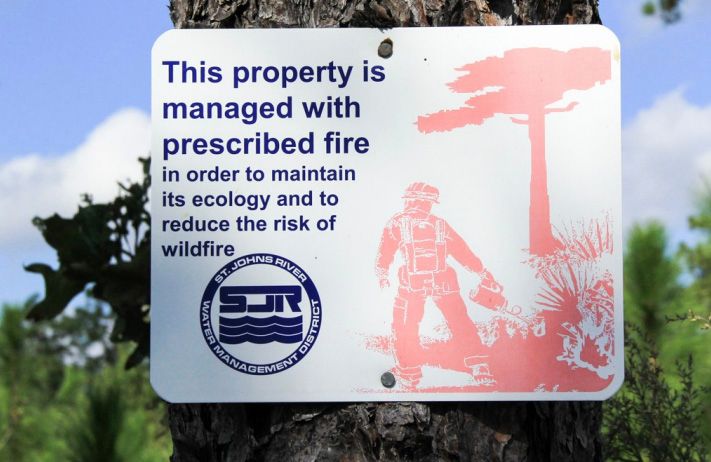
Credit: David Godwin, UF/IFAS
Additional Wildfire Protection for Homes in High-Risk Areas
Even with a well-planned defensible space, it is still possible for fires to spread through any vegetation. Be prepared to support firefighters in the event a wildfire reaches your home. Make it easy for fire trucks to get to your house. Clearly label your street name and house number with noncombustible metal signs and posts. Ensure the driveway has a 15-foot clearance of vegetation and create a 30-foot-wide defensible space around your home to allow fire trucks to maneuver. If there is no hydrant system in your neighborhood, provide an emergency water supply for firefighters, such as a swimming pool, pond, or water tank. Keep 100 feet of hose to stop small fires from spreading.
Do Not Wait Too Long...
People who live in high-risk residential areas of Florida should take precautions to protect their homes from fire. Since some preventive actions have economic and environmental costs, they are not appropriate for every homeowner. It is possible to keep an attractive yard that conserves energy, water, and wildlife while also protecting your home from wildfire. Homeowners, local landowners, and officials can gain additional fire protection by working together to develop fire protection services, water sources, and defensible space for an entire community (Parajuli et al. 2020).
Learn more about landscaping your Florida home and reducing wildland fire risk by visiting these websites.
University of Florida Websites:
Florida-Friendly Landscaping https://ffl.ifas.ufl.edu/
Landscaping for Wildlife https://wec.ifas.ufl.edu/extension/
Landscaping for Energy https://livinggreen.ifas.ufl.edu/topics/energy/landscaping-for-energy-efficiency/
Florida and National Forest Agency Websites:
Florida Forest Service https://www.fdacs.gov/Divisions-Offices/Florida-Forest-Service?original_host=www.floridaforestservice.com
Firewise https://www.nfpa.org/Public-Education/Fire-causes-and-risks/Wildfire/Firewise-USA
Smokey Bear https://www.smokeybear.com/
Good Fires and Visit My Forest https://southernforests.org/fire/prescribed-fire-in-the-south/
Other Organization Websites:
Southern Fire Exchange https://southernfireexchange.org/ Tall Timbers Research Station https://talltimbers.org/
The Nature Conservancy—Florida Chapter https://www.nature.org/en-us/about-us/where-we-work/united-states/florida/
References
Behm, A., A. Long, M. C. Monroe, C. Randall, W. Zipperer, and A. Hermansen-Báez. 2004. Fire in the Wildland-Urban Interface: Preparing a Firewise Plant List for WUI Residents (Circular 1453). Gainesville: University of Florida Institute of Food and Agricultural Sciences https://doi.org/10.32473/edis-fr151-2004
Campbell, H. 2020. Firescaping: Wildfire-Resistant Landscaping in Georgia. University of Georgia, WSFNR-20-96A. < https://bugwoodcloud.org/resource/files/18516.pdf >
Diaz, J. M. 2012. “Effects of Prescribed Fire and Wildfire: Frequently Asked Questions from Florida.” SFE Fact Sheet 2012-6 https://southernfireexchange.org/wp-content/uploads/2012-6.pdf
Doran, J. D., J. M. Fill, R. M. Crandall, C. K. Randall, and A. J. Long. 2022. “Fire in the Wildland-Urban Interface: Selecting and Maintaining Firewise Plants for Landscaping” (Circular 1445). EDIS 2004 (5). https://doi.org/10.32473/edis-fr147-2004
Fill, J. M., and R. M. Crandall. 2019. “Terrestrial Invasive Plants and Fire.” SFE Factsheet 2019-2. https://southernfireexchange.org/wp-content/uploads/2019-2.pdf
Kays, L., J. Fawcett. J. Query, H. Thompson-Welch, and R. Bardon. 2020. “Fire-Resistant Landscaping in North Carolina.” NC State Extension, NC. https://content.ces.ncsu.edu/fire-resistant-landscaping-in-north-carolina
Long, A. and A. Oxarart. 2017. “What the Research Says: Prescribed Fire and Wildfire Risk Reduction.” SFE Fact Sheet 2017-1. https://southernfireexchange.org/wp-content/uploads/2017-1.pdf
Long, A., and J. Prestemon. 2013. “Wildfire Ignitions: State of the Science in the Southeast.” SFE Fact Sheet 2013-1. https://southernfireexchange.org/wp-content/uploads/2013-1.pdf
Monroe, M. C., J. M. Fill, R. M. Crandall, and S. Marynowski. 2022. “Developing Land in Florida with Fire in Mind: Recommendations for Designers, Developers, and Decision-makers.” FOR63/FR059. EDIS 2019. https://edis.ifas.ufl.edu/publication/FR059.
Parajuli, R., J. E. Fawcett, and L. Kays. 2020. “Recent Research on Perceived Risks, Legal Liabilities, and Insurance Coverage Associated with Prescribed Burning on Private Lands.” SFE Fact Sheet 2020-2. https://southernfireexchange.org/wp-content/uploads/2020-2.pdf